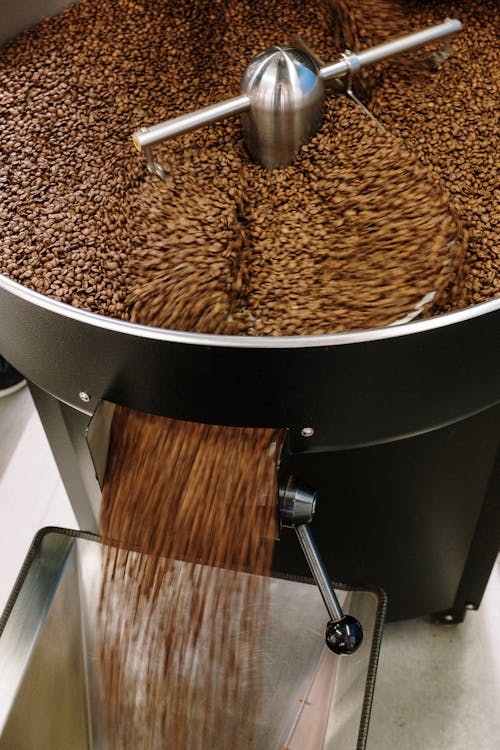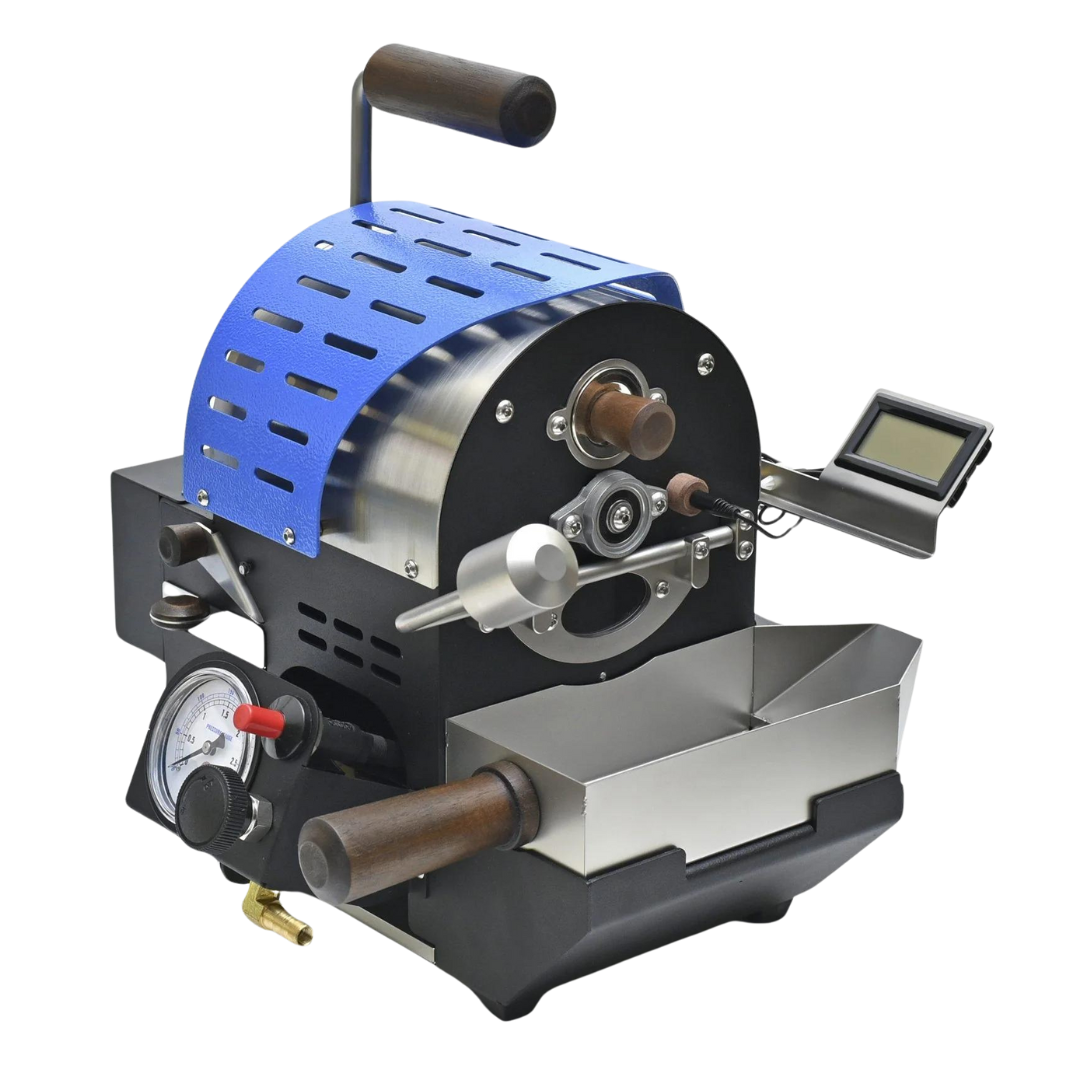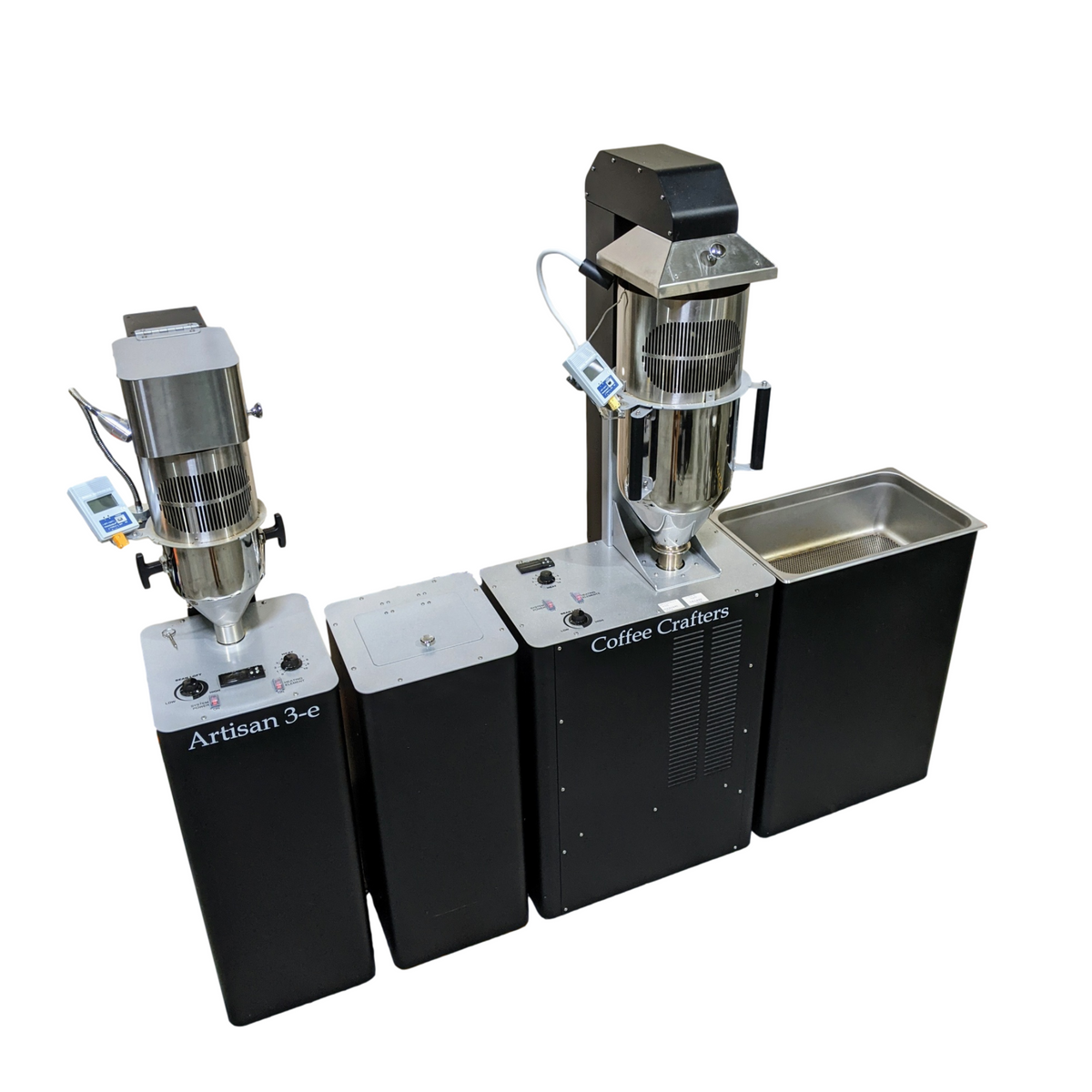"Coffee is a language in itself," the saying goes. And just like any language, coffee requires us to grasp every detail to truly appreciate it. One of the best ways to achieve this is by learning about the coffee roasting process.
In this article, we'll uncover the intricacies of coffee roasting, explore the 'how' and the 'what' that define this essential phase in coffee production, and ultimately reveal the profound impact roasting has on your favorite cup's flavor and aroma.

The Process of Coffee Roasting
Coffee roasting is the transformative process that turns green, flavorless coffee beans into rich, aromatic ones, integral to creating a superior brew. This meticulous art involves careful heating to enhance inherent flavors while developing new, complex ones, distinguishing a premium coffee experience from your everyday cup.
Through precise control of temperature and time, roasters unlock each bean's potential to deliver a rich, full-bodied flavor that can't be achieved by brewing alone.
In this exploration, we delve into how roasting elevates coffee, providing depth and character that sets it apart, and enriching your appreciation for every sip.
The Science Behind Roasting Coffee Beans

Heat plays an essential role in transforming green coffee beans during roasting, unveiling the depth of flavor and aroma we expect from our coffee. These beans start off with a subtle, grassy scent, vastly different from the full-bodied coffee aroma developed through roasting.
The application of heat initiates moisture loss, leading to the first significant chemical change, setting the stage for the Maillard reaction. This reaction between amino acids and sugars in the beans creates the complex, rich flavors and scents characteristic of coffee.
As roasting progresses, an audible signal known as the 'first crack' indicates that beans have expanded and their structure has begun to change, marking the transition to a light roast. Advancing the roast further intensifies the beans' flavor profiles, brings oils to the surface, and imparts a smoky nuance to the beans, indicative of darker roasts.
This progression uncovers the intricate relationship between roasting time and temperature and the coffee's ultimate taste and aroma, highlighting the scientific artistry behind your morning brew.
Key Stages of the Coffee Roasting Process

Each phase of the coffee roasting process meticulously transforms green beans into the flavorful, aromatic coffee we savor. To learn more on "how" it is made, and to ensure you achieve the desired roast, here are the key stages you should follow:
Drying Stage

Initiating the process, the drying stage is where the beans are gradually heated to remove moisture. This phase is critical as it sets the foundation for effective roasting, transitioning the beans from green to a pale yellow.
During this period, the beans must be heated evenly and gently to prevent any premature roasting or burning, ensuring they achieve uniform dryness and are ready for the subsequent stages of flavor development.
Browning Stage

Following the drying stage, the beans transition into the browning stage, marked by the Maillard reaction—a crucial chemical exchange between amino acids and sugars inside the bean, pivotal for developing the complex flavors and aromas that characterize the coffee's essence.
It's during this stage that the first crack occurs, an audible signal indicating that the beans have expanded and moisture has been sufficiently released, ushering in the browning process. As the beans achieve a rich brown color and emit a toasted aroma, their distinct roast qualities begin to emerge. Close attention to this stage is essential, as it ensures the flavor profile evolves precisely, capturing the intended nuances of the roast.
Development or Roasting Stage

Finally, the development or roasting stage is where the beans undergo their final transformations. This stage is critical for solidifying the beans' flavor, aroma, and body profile. The occurrence of the 'first crack' is a crucial indicator that the beans have reached a light roast. Extending the roast beyond this point allows for the development of medium to dark roasts, depending on the duration and intensity of heat application.
The roaster must make a timely decision to halt the roast, capturing the precise roast level desired. Immediate cooling follows, which is essential to stabilize the beans and lock in the intricate flavors and aromas they've acquired.
This stage concludes the roasting process, resulting in a batch of coffee beans that are not just roasted but are imbued with a rich tapestry of flavors and aromas, reflecting the meticulous care and expertise applied throughout their transformation.
By understanding these key stages, one can appreciate the intricate process behind coffee roasting, recognizing it as an art that significantly enhances the coffee experience, offering insights into the craft that turns simple beans into the centerpiece of our cherished coffee rituals.
Choosing the Right Coffee Roaster Design

Having the right coffee roaster design is crucial in defining the final quality of your coffee, directly affecting the flavor profile and consistency of the roast. The two main types, drum roasters and fluid bed (or hot air) roasters, each offer unique benefits and influence the roasting process differently.
By comprehending the specific characteristics and advantages of drum and fluid bed roasters, you can make an informed decision that aligns with your roasting goals and preferences, ensuring the desired outcome in every batch.
Drum roastersuse either direct or indirect heat, where beans rotate in a drum to ensure even roasting. This design is preferred for its ability to produce a wide range of roast levels, from light to dark brown, and is widely used in commercial roasting.Fluid bed roasters, on the other hand, use hot air to roast the coffee beans, offering quicker roast times and a more uniform heat distribution. This can be ideal for achieving lighter roasts with a clean, uniform flavor. Each design has its unique impact on the beans, from the development of flavor and aroma to the roast character, making the choice of roaster crucial for the desired end product.
Tailoring Roast Profiles for Filter and Espresso Brews
The roasting approach can vary significantly depending on whether the coffee is destined for filter brewing or espresso.
For filter coffee, which involves a gentler extraction process, roasters often aim for a light to medium roast. This preserves the coffee's inherent flavors, acidity, and aroma, resulting in a more nuanced and complex cup.

On the other hand, espresso roasting typically involves a darker roast. The intense pressure and rapid extraction of espresso benefit from the fuller body and richer flavor profile that darker roasts provide. However, modern trends are seeing more experimentation with lighter roasts for espresso, offering a brighter and more diverse flavor experience.
Understanding the Impact of Roast Levels on Your Coffee

Roast levels profoundly shape the character of your coffee, influencing everything from its taste to its aroma and body. Here's a more structured and detailed exploration of these levels:
Light Roasts
Characterized by a light brown color, light roasts have no oil on the bean surfaces. They preserve much of the coffee's original flavor, reflecting the bean's inherent qualities shaped by its origin, variety, and processing. These roasts deliver a coffee that's bright and lively, often with higher acidity and pronounced flavors, ideal for those who appreciate the subtle nuances and true essence of the coffee bean.
Medium Roasts
Medium roasts exhibit a richer brown color and still lack oil on the bean surfaces. They represent a harmonious balance, diminishing some green bean traits while introducing more roast-induced flavors. This level enhances the coffee's body and mellows its acidity, producing a cup that offers a more rounded flavor experience, making it a favorite for those seeking a middle ground in taste intensity and complexity.
Dark Roasts
Dark roasts are easily recognized by their darker color and oily bean surfaces. They undergo a longer roasting time, which significantly alters their flavor profile. The original flavors of the bean are mostly eclipsed by the flavors from the roasting process, yielding a coffee that's full-bodied, rich, and bold, with reduced acidity. These roasts are particularly favored for espresso due to their robust flavor and the creamy consistency they lend to the coffee.
The choice of roast level is more than a mere preference; it's a decision that impacts the sensory aspects of your coffee experience. Each level offers distinct attributes in terms of aroma, flavor, and body, catering to a variety of palates and preferences. Understanding these roast levels enables you to select coffee that resonates with your taste, whether you crave the subtle, intricate profiles of lighter roasts or the bold, intense notes of darker varieties.
FAQS

What is coffee roasting and why is it important?
Coffee roasting is the process of heating green coffee beans in a coffee roaster to transform them into the flavorful, aromatic beans used in brewing. This process is crucial because it develops the coffee's rich flavors and aromas that we enjoy in our daily cup.
How does roast level affect the taste of coffee?
Roast levels significantly impact the flavor of coffee. Light roasts tend to be more acidic and retain more of the bean's original flavors, while dark roasts are less acidic with a fuller body and richer flavor.
Can I roast coffee at home?
Yes, coffee can be roasted at home using various methods, from simple popcorn poppers to specialized home coffee roasters. It requires close observation and control of temperature to achieve desired results.
Bottomline
The transformation of coffee from its humble beginnings as a green bean to the delightful beverage in your cup is an extraordinary saga, steeped in both age-old tradition and cutting-edge innovation. Delving into the art of coffee roasting can profoundly deepen your appreciation and pleasure in every sip. Whether you're keen on trying your hand at roasting beans at home or simply wish to gain a deeper understanding of your daily java, the domain of coffee roasting brims with insights and revelations.

If you're intrigued and ready to learn more, especially about the distinct roast levels and their specific impacts on flavor, we warmly encourage you to continue your exploration. Understanding these roast profiles will not only enhance your enjoyment of coffee but also empower you to choose the ideal roast that resonates with your palate.
Click here for a detailed article on that delves deeper into the varied world of coffee roasts, and while you're at it, share this article with your coffee-loving friends and family to keep them informed as well! Grab this chance to enhance your coffee knowledge and fine-tune your preferences, elevating every coffee moment you cherish. Uncover your ideal roast and turn your coffee experiences into a true celebration of taste and skill.







Dejar un comentario